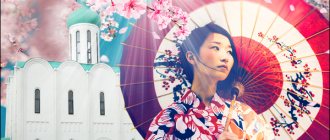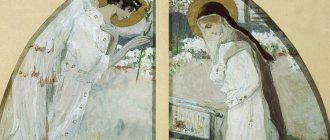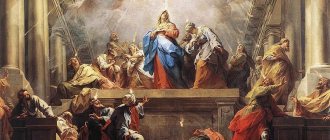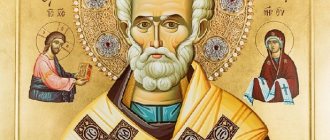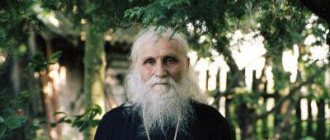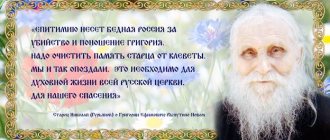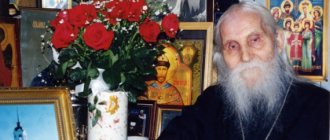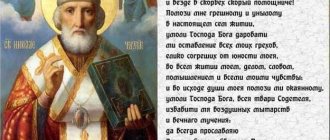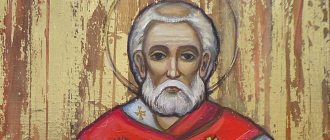Japan, until the beginning of the 20th century, was hostile towards everything foreign. The Japanese viewed faith in Christ with particular wariness. A serious role in this was played by the first collision of the “country of Nippon” with the religion of Christ, which occurred in the 16th century through the Portuguese and Spanish Jesuits. However, a man appeared who not only managed to reconcile the Land of the Rising Sun with Christianity, but also convert more than 30 thousand of its inhabitants to Orthodoxy. This ascetic is Saint
Nicholas
,
Equal to Archbishop of Japan
(before he was tonsured
Ivan Dmitrievich Kasatkin ).
Nicholas, Archbishop of Tokyo and Japan
Childhood and youth
Ivan Dmitrievich was born near Smolensk. His father was a village deacon. This happened in 1836. His parents were poor people, but they were able to give their son a good education. Theological school, seminary, and, finally, the St. Petersburg Theological Academy.
Useful materials
In 1862, when the young man was already completing his course at the academy, a notice appeared that a priest was being invited to the church at the Russian consulate in Japan. The young man, who had never thought about the Land of the Rising Sun before, decided to go there. This happened during the all-night vigil. He came to his superiors with a statement of desire to become the rector of a temple in the city of Hakodate and with a request for monastic tonsure.
First, tonsure took place, and a few days later the monk Nicholas was ordained subdeacon, and then hieromonk. Father Nikolai was 26 years old at that time.
Prayers
Troparion, tone 4
The Apostles are equal and co-throne, faithful and God-wise servant of Christ, chosen priest of the Divine Spirit, overflowing vessel of the love of Christ, enlightener of the Japanese land, Saint Nicholas, hierarch equal to the apostles, pray to the Life-Giving Trinity for all your flock and for the whole world.
Kontakion, tone 4
The country of Japan, equal to the Apostles with St. Nicholas, welcomed the stranger and the stranger, in it you first recognized yourself as a stranger, both exuding the warmth and light of Christ, you turned your enemies into spiritual sons, distributing the grace of God to them, you built the Church of Christ, about it Now pray, and to you her sons and daughters cry: Rejoice, our good shepherd.
Arrival in Japan
Arriving in Japan, Father Nikolai discovered a world there that was completely different from everything he had encountered before, an ancient, unique culture, very beautiful and deep in its own way, but in many ways antagonistic to everything foreign, and especially to Christianity.
In his letters, he mentioned that the Japanese laugh at him and even throw stones at him when he walks down the street in his robes. However, the young priest did not limit himself to services in the church at the consulate, but decided to devote himself to a task that, at first glance, was completely unthinkable - preaching Orthodoxy among the Japanese. And for this it was necessary to stop being a stranger to the local residents. And Father Nikolai began to learn the language and comprehend the island customs.
It took five years.
Considering that Japanese is one of the most difficult languages for a European, Father Nikolai mastered not only colloquial speech, but also a refined literary language, read works of art and religious texts of Shintoism and Buddhism.
He diligently delved into the peculiarities of the etiquette of the Japanese, their everyday behavior, in a word, he did everything in order to better understand this people, to become for the Japanese, if not completely his own, then at least not completely alien. Only in this case did he consider it possible to begin preaching the Orthodox faith on the Japanese islands.
First baptisms
The activities and prayers of Father Nicholas were not in vain, and Christians began to appear in Japan The first of the residents who was baptized by Father Nikolai was the samurai Takuma Sawabe, at first his worst enemy, later his faithful follower and continuer of the work.
Sawabe-san came from an old and warlike family; he visited the house of the Russian consul to teach fencing to the consul's son. In addition, he was a priest of one of the Shinto shrines in Hakodate. It is not surprising that he was an adherent of the traditional culture of the Japanese islands and really disliked everything foreign, especially the Christian faith.
Meeting with the Russian priest at the consulate, he looked at him with undisguised anger. And one day Father Nikolai turned to him with a question:
“Why do you hate me so much, Sawabe-san?” And the samurai said that he saw only evil in Christianity, since its preaching could harm Japan. “Are you familiar with my teaching?” - the hieromonk asked again.
Having reasoned that it is indeed stupid to hate something about which you have no idea, Takuma Sawabe began to listen to the explanations of the Russian hieromonk and ask questions.
He began to often come to him for conversations on spiritual topics, and brought with him two more seekers of truth - Sakai Atsunori and Urano. These people became the first followers of Father Nicholas on the Japanese Islands. In 1868 the saint baptized them. Savabe became Paul, Urano became James, Sakai became John.
Everything was done in deep secrecy, since in Japan at that time Christians were prohibited from carrying out missionary activities. This was a time when Japan was torn by civil unrest, and great care had to be taken not to provoke a surge of fanaticism among the champions of the old traditions.
Fruit
The first three years were the most difficult for him. Japanese Nicholas closely observed the life of the Japanese, visited their Buddhist temples and listened to preachers.
At first they took him for a spy and even set dogs on him, and the samurai threatened him with violence. But in the fourth year, Nicholas of Japan found his first like-minded person who believed in Christ. It was the abbot of the Shinto shrine, Takuma Sawabe. A year later they got another brother, then another. Takume received the name Paul at baptism, and ten years later the first Japanese Orthodox priest appeared. In this rank he had to go through difficult trials.
Creating a Spiritual Mission
Six months after the baptism of the first converts, the civil unrest ended. Japan turned its face to the West, to change and progress. This was the so-called Meiji era. The persecution of followers of faith in Christ also stopped. Father Nikolai went to the capital of the Russian Empire with a request to create a Russian spiritual mission in Japan. This proposal was supported by the Holy Synod and the sovereign.
The newly created mission came under the command of the Bishop of Kamchatka. Its strongholds were located in Kyoto, Tokyo, Hakodate and Nagasaki. Father Nikolai, already in the rank of archimandrite, was appointed head of the mission. In 1871, Archimandrite Nicholas returned to the islands, and more priests followed him. A year later, the head of the Russian Orthodox mission in Japan moved to Tokyo, entrusting the temple in Hakodate to his deputy.
The main task of the saint from now on is to translate the Gospel and other Christian texts into Japanese. He began this work while still in Hakodate, and now he devoted all his strength and all his time to it.
Initially, services in Orthodox churches in the Land of the Rising Sun were held in Church Slavonic; only “I Believe,” “Our Father,” “Lord, have mercy,” and some other prayers were said in Japanese. But in the tradition of Orthodoxy, it is to serve in the native language of the parishioners. Therefore, Vladyka Nikolai began this titanic work, which became the feat of his entire life.
In order to translate the New Testament, he had to turn, with the help of translators, to the Chinese and English versions of the text, as well as consult the Septuagint (Septuaginta is the first Greek translation of the Old Testament, made during the 3rd-2nd centuries BC The Old Testament in this translation played a huge role for the Church.), Vulgate (lat. Biblia Vulgata “Common Bible” - a Latin translation of the Holy Scriptures, based on the works of Jerome of Stridon).
Interesting fact
Saint Nicholas made available to the Japanese the New Testament, the Apostle, the Prayer Book, the Lenten and Colored Triodion, as well as parts of the Old Testament necessary for Divine Services, and many other spiritual works necessary for reading by laymen and clergy.
For 30 years, Father Nicholas and his assistants from newly converted Christians, among whom there were many educated people who knew languages, worked on translations of sacred texts.
During the war
When the Russo-Japanese War broke out, many Orthodox priests left the islands and returned to Russia. But Father Nicholas, who by that time had already received the rank of bishop, asked his large flock by that time not to leave them. And he made the difficult decision to stay with his spiritual children, despite the fact that his state was at war with Japan.
He occupied himself exclusively with translations alone, interrupting communication with Russia and participation in divine services. The reason was simple - during the service, prayers are offered for the country and the army, and the saint could not afford to publicly pray for Russia in a country that was at war with it. His parishioners could be put in a difficult position by this. At the same time, he sent messages to all parishes in which he blessed the Orthodox Japanese to pray for Japan and the Japanese army.
When Russian prisoners of war began to be brought to the islands, the bishop did everything to ease their fate. A special society was created to help prisoners of war. Father Nicholas himself was not allowed to see them, but his disciples and parishioners came to the prisoners and brought them food, medicine, pastoral instructions and words of support from the bishop.
The behavior of Father Nikolai during the war, his wisdom and courage were highly appreciated both by Japanese society and in Russian government circles.
An excerpt characterizing Nikolai of Japan
The comrade soldiers walking next to Pierre did not look back, just like him, at the place from which a shot was heard and then the howl of a dog; but a stern expression lay on all faces. The depot, the prisoners, and the marshal's convoy stopped in the village of Shamsheva. Everything huddled around the fires. Pierre went to the fire, ate the roasted horse meat, lay down with his back to the fire and immediately fell asleep. He slept again the same sleep that he slept in Mozhaisk after Borodin. Again the events of reality were combined with dreams, and again someone, whether he himself or someone else, told him thoughts, and even the same thoughts that were spoken to him in Mozhaisk. “Life is everything. Life is God. Everything moves and moves, and this movement is God. And as long as there is life, there is the pleasure of self-consciousness of the deity. Love life, love God. It is most difficult and most blissful to love this life in one’s suffering, in the innocence of suffering.” “Karataev” - Pierre remembered. And suddenly Pierre introduced himself to a living, long-forgotten, gentle old teacher who taught Pierre geography in Switzerland. “Wait,” said the old man. And he showed Pierre the globe. This globe was a living, oscillating ball that had no dimensions. The entire surface of the ball consisted of drops tightly compressed together. And these drops all moved, moved and then merged from several into one, then from one they were divided into many. Each drop sought to spread out, to capture the greatest possible space, but others, striving for the same thing, compressed it, sometimes destroyed it, sometimes merged with it. “This is life,” said the old teacher. “How simple and clear this is,” thought Pierre. “How could I not know this before?” “There is God in the middle, and every drop strives to expand in order to reflect him in the greatest possible size. And it grows, merges, and shrinks, and is destroyed on the surface, goes into the depths and floats up again. Here he is, Karataev, overflowing and disappearing. “Vous avez compris, mon enfant, [You understand.],” said the teacher. “Vous avez compris, sacre nom, [You understand, damn you.],” a voice shouted, and Pierre woke up. He rose and sat down. A Frenchman, who had just pushed aside a Russian soldier, sat squatting by the fire and was frying meat that had been put on a ramrod. Veiny, rolled-up, hairy, red hands with short fingers deftly turned the ramrod. A brown gloomy face with frowning eyebrows was clearly visible in the light of the coals. “Ca lui est bien egal,” he grumbled, quickly turning to the soldier standing behind him. -...brigand. Va! [He doesn’t care... a robber, really!] And the soldier, twirling the ramrod, looked gloomily at Pierre. Pierre turned away, peering into the shadows. One Russian soldier, a prisoner, the one who had been pushed away by the Frenchman, sat by the fire and ruffled something with his hand. Looking closer, Pierre recognized a purple dog, which, wagging its tail, was sitting next to the soldier. - Oh, did you come? - said Pierre. “Ah, Pla...” he began and didn’t finish. In his imagination, suddenly, at the same time, connecting with each other, a memory arose of the look with which Plato looked at him, sitting under a tree, of the shot heard in that place, of the howl of a dog, of the criminal faces of two Frenchmen who ran past him, of the filmed a smoking gun, about the absence of Karataev at this halt, and he was ready to understand that Karataev was killed, but at the same moment in his soul, coming from God knows where, a memory arose of the evening he spent with the beautiful Polish woman, in the summer, on the balcony of his Kyiv house. And yet, without connecting the memories of this day and without drawing a conclusion about them, Pierre closed his eyes, and the picture of summer nature mixed with the memory of swimming, of a liquid oscillating ball, and he sank somewhere into the water, so that the water converged above his head. Before sunrise, he was awakened by loud, frequent shots and screams. The French ran past Pierre. - Les cosaques! [Cossacks!] - one of them shouted, and a minute later a crowd of Russian faces surrounded Pierre. For a long time Pierre could not understand what was happening to him. From all sides he heard the cries of joy of his comrades. - Brothers! My dears, my dears! - the old soldiers cried, crying, hugging the Cossacks and hussars. Hussars and Cossacks surrounded the prisoners and hurriedly offered them dresses, boots, and bread. Pierre sobbed, sitting among them, and could not utter a word; he hugged the first soldier who approached him and, crying, kissed him. Dolokhov stood at the gate of a ruined house, letting a crowd of disarmed French pass by. The French, excited by everything that had happened, spoke loudly among themselves; but when they passed by Dolokhov, who was lightly whipping his boots with his whip and looking at them with his cold, glassy gaze, promising nothing good, their conversation fell silent. On the other side stood the Cossack Dolokhov and counted the prisoners, marking hundreds with a chalk line on the gate. - How many? – Dolokhov asked the Cossack who was counting the prisoners. “For the second hundred,” answered the Cossack. “Filez, filez, [Come in, come in.],” Dolokhov said, having learned this expression from the French, and, meeting the eyes of passing prisoners, his gaze flashed with a cruel brilliance. Denisov, with a gloomy face, having taken off his hat, walked behind the Cossacks, who were carrying the body of Petya Rostov to a hole dug in the garden. From October 28, when frosts began, the flight of the French only took on a more tragic character: people freezing and roasting to death at the fires and continuing to ride in fur coats and carriages with the looted goods of the emperor, kings and dukes; but in essence, the process of flight and disintegration of the French army has not changed at all since the speech from Moscow. From Moscow to Vyazma, out of the seventy-three thousand strong French army, not counting the guards (which throughout the war did nothing but plunder), out of seventy-three thousand, thirty-six thousand remained (of this number, no more than five thousand died in battles). Here is the first term of the progression, which mathematically correctly determines the subsequent ones. The French army in the same proportion melted and was destroyed from Moscow to Vyazma, from Vyazma to Smolensk, from Smolensk to Berezina, from Berezina to Vilna, regardless of the greater or lesser degree of cold, persecution, blocking the path and all other conditions taken separately. After Vyazma, the French troops, instead of three columns, huddled together in one heap and continued like this until the end. Berthier wrote to his sovereign (it is known how far from the truth the commanders allow themselves to describe the situation of the army). He wrote: “Je crois devoir faire connaitre a Votre Majeste l'etat de ses troupes dans les differents corps d'annee que j'ai ete a meme d'observer depuis deux ou trois jours dans differents passages. Elles sont presque debandees. Le nombre des soldats qui suivent les drapeaux est en proportion du quart au plus dans presque tous les regiments, les autres marchent isolement dans differentes directions et pour leur compte, dans l'esperance de trouver des subsistances et pour se debarrasser de la discipline. En general ils regardent Smolensk comme le point ou ils doivent se refaire. Ces derniers jours on a remarque que beaucoup de soldats jettent leurs cartouches et leurs armes. Dans cet etat de choses, l'interet du service de Votre Majeste exige, quelles que soient ses vues ulterieures qu'on rallie l'armee a Smolensk en commencant a la debarrasser des non combattans, tels que hommes demontes et des bagages inutiles et du materiel de l'artillerie qui n'est plus en proportion avec les forces actuelles. En outre les jours de repos, des subsistances sont necessaires aux soldats qui sont extenues par la faim et la fatigue; beaucoup sont morts ces derniers jours sur la route et dans les bivacs. Cet etat de choses va toujours en augmentant et donne lieu de craindre que si l'on n'y prete un prompt remede, on ne soit plus maitre des troupes dans un combat. Le 9 November, a 30 verstes de Smolensk.” [It is my duty to inform Your Majesty about the condition of the corps that I examined on the march in the last three days. They are almost in complete disarray. Only a quarter of the soldiers remain with the banners; the rest go on their own in different directions, trying to find food and get rid of service. Everyone thinks only about Smolensk, where they hope to relax. In recent days, many soldiers have thrown away their cartridges and guns. Whatever your further intentions, the benefit of Your Majesty’s service requires gathering corps in Smolensk and separating from them dismounted cavalrymen, unarmed ones, excess convoys and part of the artillery, since it is now not in proportion to the number of troops. Food and a few days of rest are needed; the soldiers are exhausted by hunger and fatigue; In recent days, many have died on the road and in bivouacs. This distress is continually increasing, and makes us fear that, unless prompt measures are taken to prevent the evil, we will soon have no troops at our command in the event of a battle. November 9, 30 versts from Smolenko.]
Death of the saint
Nicholas of Japan died in 1912, surrounded by students, followers and admirers. A year before his death, he managed to celebrate the fiftieth anniversary of his service on Japanese soil. He was surrounded by exceptional respect and veneration of the local population, not only the Orthodox Japanese, but also those who remained committed to traditional cults.
He handed over the mission to the capable hands of his followers and died with a calm heart for his life’s work. On the day of his funeral, among a sea of flowers and wreaths, one could see a wreath from the emperor - a rare sign of respect that foreigners had never received.
10
April
1970
Equal-to-the-Apostles Archbishop of Tokyo and Japan St. Nicholas was canonized as a saint
Now there are churches in the name of St. Nicholas of Japan, Equal-to-the-Apostles. One of them was erected in the village of Mirny, Tver Region. recently organized parish with a new church of St. Nicholas of Japan in Minsk . icon is also located there. The saint’s memory is honored on February 16.
The name of the saint is surrounded in Japan with no less, if not more, respect than ours. Thanks to his works, a lot was done in this country to strengthen Orthodoxy:
- a cathedral and several churches in other cities were built in the capital of the country;
- 276 parishes organized;
- the number of parishioners reached 34,000;
- Saint Nicholas trained 8 deacons, 34 priests and one bishop.
And currently, among Japanese Christians, 36 thousand are Orthodox. For the most part, these are descendants of those who were baptized during the life of Father Nicholas.
Iconography
Nicholas of Japan is traditionally portrayed as a missionary pastor. On the classical icons of the Old Russian school of icon painting, the minister is depicted in the vestments of an archimandrite.
His finger represents a gesture of blessing, his other hand holds the Gospel. A feature that speaks of a slavish attitude towards the relic is the use of a white scarf placed under the holy book. Modern icons depict Nicholas of Japan as an archimandrite with an open book of the Gospel, which indicates his active missionary activity. There are several icons on which the archimandrite is depicted in full growth, but in the same vestments. There are no books in the hands of the saint; his hands are turned palms up, as if intended for prayer.
